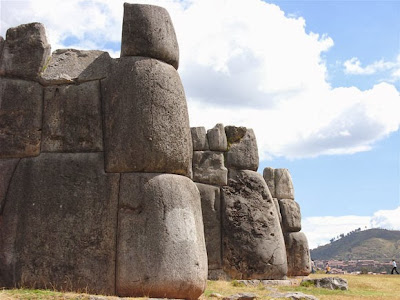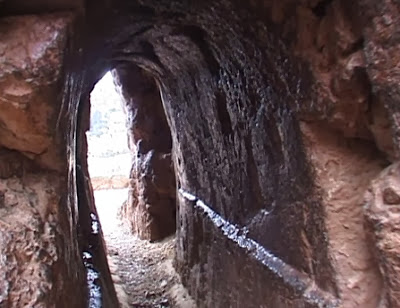 |
| Sacsayhuaman Aerial View |
It contains 200 plus archaeological sites and the archaeological park is at the north of the city of Cusco covering an area of around 3,094 hectares. There are two paved roads leading to Saqsaywaman which begins in the old traditional neighborhood of San Cristobal which is 1.5 km long while the other road which is 4 km long, starts at Avenida Collasuyo. These sites were marked by water forming their own territorial domains which had arrived through underground canals along with many houses. Some researchers are of the opinion that they belonged to one or many clans. Sacsayhuaman was built with the formation of stones smartly placed together in order to protect the city of Cusco. It was presumed to be completed around 1508 and took a crew of around 20,000 to 30,000 men who worked for 60 years.
The rampart or the wall was the most attractive section which was built of huge carved limestone boulders having a broken line facing the main plaza named Chuquipampa, a slope of about 25 angles along with 60 walls. The first wall of the biggest carved boulder weighed 70 tons and was brought from the Sisicancha quarry which is around three km away. Each of these walls is made up of 10 fronts while the most important ones are Achuanpunku, Tiupunku, Rumipunco and Viracocha punku. This monument has an amazing structure where the stones fit perfectly without the presence of any mortar and no steel or blade of grass can slide between the stones. Scientist are of the opinion that the masonry could have worked after carving the desired shape out of the first boulder and then fitting it in its desired place and the masons could have suspended the second boulder on scaffolding next to the previous boulder. They could have also traced out a pattern on the proceeding boulder to plan an appropriate jigsaw shape which would fit the shape in perfect place. Plenty of hard work in shaping and fitting the boulder in place could have been done by using a straight stick with a hanging plum bob, to trace the edges and then marking off the correct point and carving to fit it on the next boulder. On tracing the desired pattern, they could have sculpt the stone into a proper shape with hand sized stones pounding it to get the general shape before using finger sized stones for accuracy.
The walls found are around the areas of Cusco and the Urubamba River Valley in Peruvian Andes though a few are scattered in other areas of Andes. These structures are unique and beyond our understanding, baffling modern man who are neither capable to duplicate or explain on this amazing monument. The remains of the three walls indicate that the walls were made with lime stones which were used to build the foundation or the base while the main walls were made of blackish igneous stones or andesites, the quarries of which are in Waqoto on the northern mountain area of San Jeronimo or 35 km in Rumiqolqa from the city.
The Sacsayhuaman destruction lasted around 400 years since 1536 when a war broke out against the Spaniards and Manko Inka sheltered himself in this structure. At a later stage, the first conquerors began using these stones to build their houses in the city and subsequently in 1559, the city’s Church Council ordered to take them for construction of the Cathedral. Till 1930, the neighbors of Qosqo could take the stones they needed to build their houses in the city by paying a small fee and with four centuries of destruction; this complex was used as a quarry by the colonial city’s stone masons in their building structures. Archaeologists relate that the walls of Sacsayhuaman rose to around ten feet higher than their remnants and additional ten feet of stones supplied the building material for the cathedrals. It is presumed that the upper part of the walls which were small regularly shaped stones were the only part of Sacsayhuaman built by the Incas and completed in 1508 which could explain the reason why no one at the time of the conquest seemed to know about the structure of the mighty walls.





No comments:
Post a Comment
Note: Only a member of this blog may post a comment.